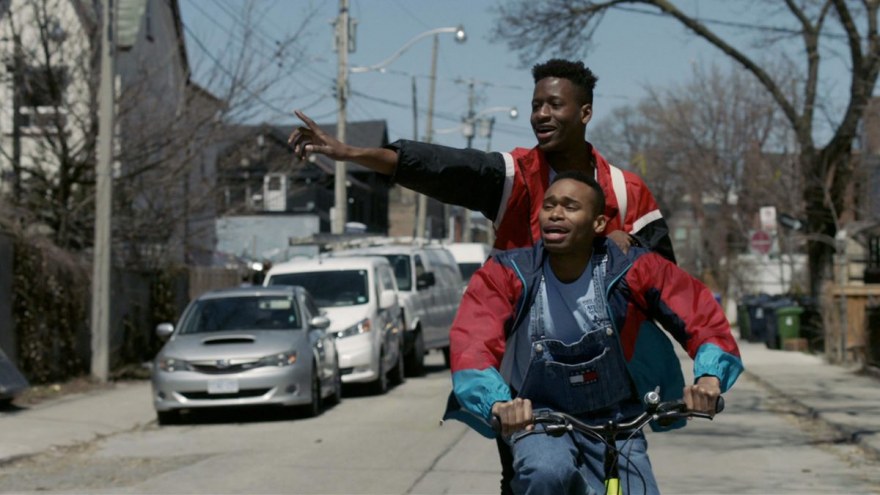Dinner with Haus
An interview with Joseph Amenta, director of Haus
Can you explain the title Haus?
The title Haus has many meanings as it pertains to the subject of the film. The direct link to “Haus” is the word “house” which is something our lead, Makai, has recently lost due to the conflicts he has had with his mother’s discovery of him being a queer man. A “house”, and by extension a “home”, is something Makai lacks and is seeking in the film. He is searching for a “home”, a family, and understanding. The word “Haus” is also used in queer culture as slang spelling for the word “house” when addressing a group of people who have come together as a collective family not connected by blood, but by experience. The “Haus of Extravaganza” is a famous “house”, or collective, that was pinnacle in Ballroom culture in Harlem New York during its origin. The title is an homage to that. Finally, the German spelling for the word “house” is “haus” which has been adapted in queer culture to mean, “exceptional”, “powerful”, or “best of the best”.
Can you shed light on the Kiki Ball concept? How did you get to know the community of dancers and performers involved?
The Kiki Ballroom culture is an underground queer community that originated from the traditional Ballroom culture of the 1980s in Harlem New York. This culture is a party and a competition, where different Houses compete in different elements of performance, such as runway walk, vogue performance, realness, and sex siren. These categories are judged by a panel of their peers, and the winner is given recognition and sometimes a trophy or a cash prize. A Kiki Ball is similar to this, but on a smaller local scale, where the “Legendary Houses” are not directly represented. These Balls are looser, and less strict, allowing for newcomers, like our lead Makai, to become involved without a long history in the community. Ballroom culture is a community where winning a category results in a small queer fame, it allows for celebration of marginalized peoples by other marginalized peoples. I got involved by paying respect to the world of Ballroom. I attended practices, and would watch for hours, getting to know different members of the community. I would walk and compete in Balls to show my commitment to the community. Ballroom culture is very close knit, and can be defensive and distrusting, so I knew I needed to pay attention to take the time to understand the world before exploring it on film.
Who or what inspired you the character of Makai?
Makai reflects the lives of many members of the LGBTQ community, especially those who come from immigrant families or are people of colour. Queer youths are often rejected by their birth families and must then dive into the LGBTQ world in search of a new family. Makai speaks to my own experience in an indirect way, and the two leads of my film, Mark Ché Devonish and James Bailey, both inspired the material following their involvement. I cast them from the Ballroom community, neither of which were actors previously. It was important for me to represent the world of the film, and the character of Makai, as authentically as possible.
Can you tell us about your work and ambitions as a filmmaker?
My goal as a filmmaker is to continue diversifying the queer stories being shown in cinema. I want to move away from the tropes of “coming out of the closet”, or “being bullied in high school”, which has currently encapsulated the queer filmic experience. I want to diversify the representation of queer cinema with feminine expressing leads, and have people of colour at the forefront of the story. I think there is a whole world of stories that have not been explored, and I am surrounded by those stories daily. I want to develop these stories into engaging cinematic expressions that display authentic human experiences, and by extension, create sociopolitical change through visibility. I want to celebrate queerness, and move away from victimizing my community. I am currently developing my first feature film, which follows the lives of three adolescent boys of mixed racial origin who become enraptured in the queer world for the first time, before a loss of life forces them back to the reality they have chosen to leave behind. I’m extremely fascinated with the grit hidden in society, and the metaphoric juxtaposition of glitter and dirt. I have most recently completed a new short film entitled Flood with the Canadian Film Centre. I plan to begin the festival circuit for Flood in the summer of 2019.
Would you say that the short film format has given you any particular freedom?
Short filmmaking is something that allows for the most beautiful freedom of cinematic expression. Due to the short nature of the format, the narrative structure of storytelling is dismantled by the audience and new forms of visual experiences become available. The challenge of engaging an audience with very little time and resources as a filmmaker is a wonderful challenge, and when that challenge is overcome, the result is something special. I believe that short filmmaking is not only a developmental step to feature films, but also an integral art form in its own right. I pride myself on my short film work, and it has allowed me an immense amount of artistic freedom, without which projects like Haus would not be possible. Having a festival like Clermont-Ferrand give such a large platform to short filmmakers and their work is invaluable to the cinematic community.
Haus was shown in International Competition.









